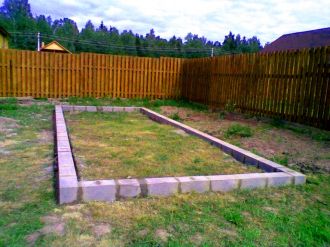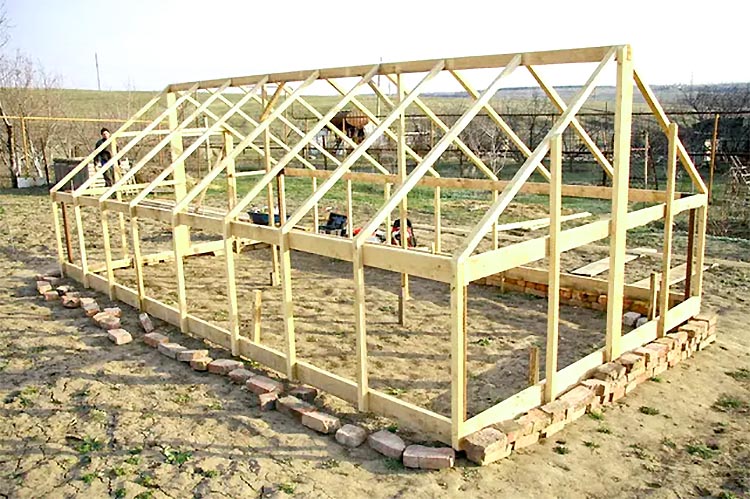 If you are going to acquire a greenhouse on the site, you need to prepare for the fact that you will have to do construction work, such as, for example, building a foundation for a greenhouse.
If you are going to acquire a greenhouse on the site, you need to prepare for the fact that you will have to do construction work, such as, for example, building a foundation for a greenhouse.
The fastest way is to build a greenhouse frame with your own hands from wood. It is possible that a wooden greenhouse will be somewhat higher in cost than one made of a metal profile (aluminum or steel), but the environmental friendliness wood áis many times superior to any other building material. The service life of a wooden frame can be up to 20 years if the base for it is made according to all the rules, and the wood itself is periodically treated with antiseptics to protect it from decay and various insects.
Before you start choosing wood for a greenhouse, you need to make a greenhouse project with your own hands, at least in the idea of a simple drawing, which makes it easier to calculate the right amount of lumber.
Coniferous wood, especially larch, is best suited for building a greenhouse frame, which is characterized by increased strength and resistance to adverse environmental conditions. Let's remember that larch houses still stand in remote villages of Siberia and the Far East.
You can also use hardwoods - oak, teak, hornbeam. But here, perhaps, there will be processing problems, since these rocks are hard and difficult to process á.
When choosing a material for a wooden frame of a greenhouse with your own hands, you should pay attention to the following factors:
Provided that the foundation for the greenhouse is ready, a lower trim bar is installed on it, with a section size of 10x10 or 15x15cm. If, during the construction of the foundation, metal pins were laid at the installation sites of the vertical racks of the frame, then holes are made for them in the beam of the lower trim. After that, the beam is mounted on the embedded parts, & nbsp; and fixed on top with studs or bolts. Between themselves, the timber along the perimeter is fastened with metal plates or cut half a tree using wood screws. This fastening allows you to disassemble the frame of the greenhouse at the right time without destroying the wood, as would happen when fastening with nails.
Vertical bars with a section size of 5x5 or 7x7 cm are attached to the bottom trim using the same self-tapping screws and metal corners. The pitch of the vertical posts is selected taking into account the covering material - glass, polycarbonate or polyethylene film.
To make the appearance of the greenhouse as pleasant as possible, all wooden elements, before making a greenhouse with your own hands, must first be cut and painted, with the wood pre-impregnated with drying oil. The fact is that the treatment with antiseptic compounds & nbsp; under the conditions that are created in the summer in a greenhouse can cause negative consequences for both plants and people working in it.
After installing the vertical posts, which are temporarily fixed with struts, the upper trim of the frame is made from a beam of a smaller section than for the lower trim, or from an edged board. The roof of the greenhouse is mounted on the upper trim. Usually, for a wooden frame, the roof of the greenhouse is made gable with your own hands. This is a simpler and more cost-effective option.
If the greenhouse is supposed to be glass, then recesses are made in all the bars that form the frame of the wall and roof for installing glass, which is fixed in the wooden structure only with nails, without glazing beads, to allow the wood to dry quickly after rains
At the length of the greenhouse, transverse bars are installed on the upper trim in increments depending on the ácovering material used. If the transparent roof is made of polycarbonate whose width is 210 cm, then the step of the transverse bars will be approximately 65-70 cm. This already depends on the exact size of the sheet and the method of joining the sheets to each other - overlap or butt. Transverse bars, which can be called puffs, perform the function of preserving the geometric dimensions of the frame from the loads acting on it from snow, roofing material.
Do-it-yourself assembly of the greenhouse continues by installing the roof rafters on the puffs, which, for additional rigidity, are unfastened by struts that connect the rafters to the puff.
It is important not to forget about the design of the ventilation system, which in this case will look like opening windows or transoms. This is very important for the effective cultivation of vegetables in a greenhouse, since the warm, humid microclimate created in the greenhouse during the hot time of the day ácontributes to the development of various diseases in plants.
The exposed rafters are interconnected by a ridge board on both sides of the greenhouse roof and additionally by transverse bars or thiná narrow boards.
At the end of the greenhouse, an entrance is arranged, with a width that should allow the passage áto the greenhouse with a wheelbarrow. Do not forget that every autumn the soil from the stationary greenhouse should be removed and a new one brought in. The height of the door is made standard 2-2.1 m from the greenhouse floor. Thus, the wooden frame of the greenhouse is assembled by hand, and now you can start laying the transparent roofing material
Comments on this post are no longer accepted.